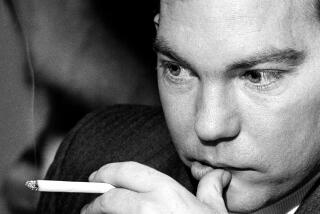Khmer Rouge by Any Other Name Is Still Evil
- Share via
Pol Pot is dead. This is noteworthy because the polite, soft-spoken, secretive man who died quietly in his sleep in a jungle hut was the most lethal mass killer in human history. From mid-1975 through 1978, he and his organization, the Maoist Khmer Rouge, were directly responsible for the death of roughly a quarter of the Cambodian population. Had they not been interrupted by a Vietnamese invasion, “the killing fields” would have continued unabated, indefinitely.
It is tempting to dwell on Pol Pot’s past, which is so horrific and unfathomable, but the more urgent question is what does his death mean for the future of Cambodia? In one sense, the story of the Khmer Rouge since its forcible removal from power has been one of decline. Pushed into remote areas along the Thai border, they mounted a guerrilla war of resistance with other non-communist Cambodians against the Vietnamese occupiers. A decade of insurgency culminated in the withdrawal of the Vietnamese army, followed in 1993 by U.N.-conducted elections. Rather than participate in the elections, the Khmer Rouge condemned and resisted the entire process. The result was its isolation while a new Cambodian government was established in Phnom Penh, composed of a coalition of noncommunists, led by Prince Norodom Ranariddh, and the cadre of the previous government installed by the Vietnamese and led by Hun Sen.
Despite the international community’s best efforts, political tensions between the two coalition partners grew steadily worse. This provided an opening for the Khmer Rouge, which still constituted a fighting force of about 8,000 guerrillas occupying strategic swaths of remote jungle and border lands.
Ranariddh and Hun Sen saw those forces as potentially decisive recruits in their ever more bitter contest for political power. Suddenly the Khmer Rouge found itself the target of competitive recruitment. The results were dramatic; the Khmer Rouge began to fracture and disintegrate as different Khmer Rouge units cut advantageous deals for themselves.
The big winner in this process was Hun Sen. This was hardly surprising because until 1978, he had been a Khmer Rouge commander. He fled to Vietnam only when he faced the prospect of becoming a victim of one of Pol Pot’s purges. The same was true for many of his close colleagues.
Senior Hun Sen allies with Khmer Rouge pedigrees in the government include the defense minister, the interior minister, the head of the National Assembly and the finance minister.
Hun Sen sealed his advantage over Ranariddh with a sudden coup last July. His forces seized control of the capital; the prince was forced to flee abroad and his key supporters were rounded up, tortured and shot.
Meanwhile, something analogous was happening within the Khmer Rouge. Pol Pot, still in control of Khmer Rouge hard-core holdouts who refused to consider compromise and are still paranoid as ever, ordered the execution of some of his closest remaining confederates. Instead, they turned on him and after a show trial, imprisoned him. As for the other “former” Khmer Rouge, they have been rapidly incorporated into Hun Sen’s regime.
Most of the young senior cadres that Pol Pot once identified as the next generation of Khmer Rouge leadership are now responsible officials in Phnom Penh. Those new recruits include the men most responsible for the Khmer Rouge gulag centered on Tuol Sleng, the infamous torture and interrogation center in Phnom Penh. Here, 16,000 Cambodians, most of them loyal Khmer Rouge cadres and their families, were systematically photographed, interrogated (with confessions duly filed and archived), tortured and killed. For anyone who believes in the essential humanity of man, Tuol Sleng, preserved today just as it was when the Khmer Rouge fled, is the most frightening place on Earth.
As Hun Sen has consolidated his power, he has sought international legitimacy with the argument that only he could prevent the Khmer Rouge’s return to power. He justified his coup on the grounds that Ranariddh was collaborating with Pol Pot.
Pol Pot’s death alters the equation in interesting ways. The Khmer Rouge hard-liners, who were hoping to trade Pol Pot in return for some sort of amnesty, have been stripped of their bargaining chit. The international community has lost the centerpiece for any tribunal that would put the killing fields on trial. Most important, Hun Sen will find the spotlight of international attention shifting from the Khmer Rouge remnants in the jungle to those in his own government. Hun Sen’s increasingly obvious drive for total power and the growing brutality of his regime will raise the ominous question of whether the Khmer Rouge is being effectively reconstituted in a new guise.
In July, the international community, including the U.S., will be asked to bless the birth of a new “democratic” Cambodian government. The question is whether a monster is being born instead.
More to Read
Sign up for Essential California
The most important California stories and recommendations in your inbox every morning.
You may occasionally receive promotional content from the Los Angeles Times.










